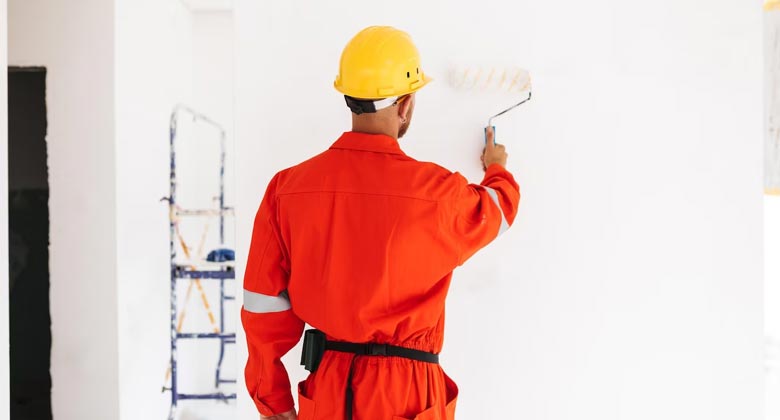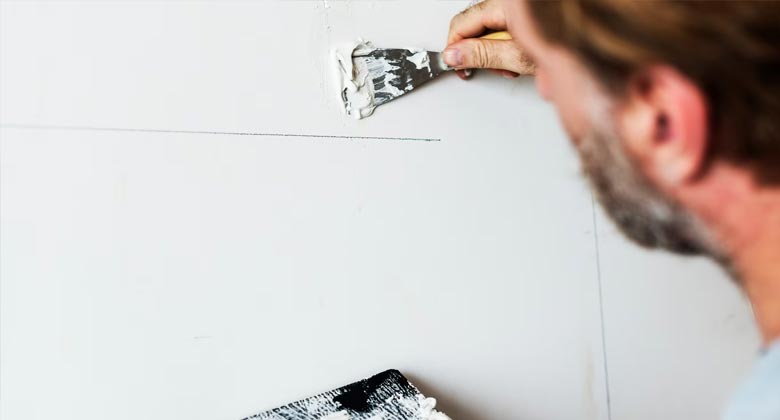Menu

Are you planning to paint your home in West Hartford? Before painting, fixing any wall cracks is essential to ensure a smooth and flawless finish. Wall cracks ruin the look of your walls and cause the paint to flake off, making your walls look even worse. In this article, we’ll provide expert tips from professional West Hartford house painters on how to fix wall cracks before painting, ensuring that your home in West Hartford looks beautiful and well-maintained.
To fix wall cracks, it’s crucial to understand the different types of wall cracks.
Hairline cracks are the most common type of wall crack found in almost every home. They’re usually less than 1/16th of an inch wide and can appear in vertical, diagonal, or horizontal patterns. Hairline cracks are caused by structural settling, which occurs when the house’s foundation settles over time. They can also be caused by temperature changes, which cause the materials in the wall to expand and contract, resulting in tiny cracks.
Spiderweb cracks, also known as craze cracks, are fine, shallow cracks that resemble a spider’s web. They can appear in any direction and be found on walls, ceilings, and furniture. Spiderweb cracks are caused by the movement of the house’s foundation, which creates stress on the wall surface. Fluctuations in temperature cause materials to expand and contract, leading to stress that can result in spiderweb cracks.
Significant cracks are deeper and wider than hairline or spiderweb cracks and can be caused by structural damage to the house’s foundation. They can also be caused by water damage, which weakens the wall surface and causes it to crack. Significant cracks can be a serious issue and should be evaluated by a professional before repairing them.

When gathering the required tools and materials, ensuring you have everything you need before starting the repair process is crucial. The right tools and materials can significantly affect the repair’s outcome, so investing in high-quality supplies is essential.
A putty knife and paint scraper are essential for removing loose paint and debris from the wall surface. A putty knife is a flat, metal tool for spreading and smoothing joint compounds. A paint scraper is used to scrape old paint from the wall surface.
A sanding block and sandpaper smooth the wall surface after the repair. Sandpaper comes in different grits, ranging from coarse to fine, and is used to smooth out the rough areas of the wall surface. A sanding block holds the sandpaper and provides a more even surface.
A paintbrush is used to apply the primer and paint to the repaired wall surface. Choose a brush with high-quality bristles to ensure that the paint goes on smoothly.
A caulking gun applies caulking to gaps and cracks in the wall surface. Caulk is a flexible sealant that fills gaps and prevents moisture from entering the wall surface.
A joint compound is a versatile material for filling in cracks and smoothing the wall surface. It’s made of gypsum powder and water and is available in different types, including all-purpose and lightweight joint compounds.
Mesh tape reinforces the joint compound and prevents cracks from reappearing. It’s a self-adhesive tape made of fiberglass and available in different widths.
Crack filler fills in deep cracks and holes in the wall surface. It’s a pre-mixed paste applied with a putty knife and dries hard like concrete.
By gathering the required tools and materials before starting the repair process, you can ensure that the repair process goes smoothly and that the result is a smooth and even wall surface.
Before repairing wall cracks, you need to prepare the wall surface for repair. This includes cleaning and sanding the area around the crack.
You want to ensure the surface is free of any dirt, grease, or dust that could prevent the joint compound from adhering to the wall surface. Professional West Hartford house painters recommend using a damp cloth to wipe down the wall surface around the crack. If there are any stains or marks on the wall surface, use a mild cleaning solution to remove them.
Before repairing wall cracks, remove any loose paint or debris from the area around the crack. Use a paint scraper to remove peeling or flaking paint from the wall surface. Make sure to scrape away any loose debris or chunks of paint to create a smooth and even surface.
Once you’ve removed any loose paint or debris, use sandpaper or a sanding block to smooth out the area around the crack. Sand the area until it’s smooth. This will ensure that the joint compound adheres correctly to the wall surface and provides a smooth and even finish.
If there are any small holes or gaps in the wall surface, professional West Hartford house painters advise using a caulk gun to fill them in with the caulk. Caulk is a flexible sealant that can fill in gaps and prevent moisture from entering the wall surface. Apply the caulk to the gap or hole and use a putty knife to smooth the surface.

To use mesh tape, apply a thin layer of joint compound over the crack using a putty knife. Then, place the mesh tape over the joint compound and smooth it out with the putty knife. Make sure that the tape is fully embedded in the joint compound.
After applying the mesh tape, allow the joint compound to dry completely. The drying time will depend on the crack size and the room’s humidity level. Professional West Hartford house painters recommend waiting at least 24 hours before sanding down the joint compound.
After the joint compound has dried, use sandpaper or a sanding block to smooth the surface. Sand the area around the crack until it’s smooth and even with the surrounding wall surface. Wipe down the area with a damp cloth to remove dust or debris.
Use a crack filler to fill the gap for deep cracks or holes. Crack filler is a pre-mixed paste that’s applied with a putty knife. Apply the crack filler to the gap or hole and smooth it out with the putty knife. Make sure that the crack filler is level with the surrounding wall surface.
After applying the crack filler, allow it to dry completely. The drying time will depend on the size of the crack and the humidity level in the room. Professional West Hartford house painters advise waiting at least 24 hours before sanding the crack filler.
Once the crack filler has dried, the next step is to prepare the surface for painting or further treatment. This involves using sandpaper or a sanding block to smooth out any unevenness caused by the crack. Carefully sand around the edges of the crack until the surface is flush with the surrounding wall. Finally, wipe down the area with a damp cloth to remove any remaining dust or debris, ensuring a clean and smooth finish. This will ensure that the wall surface is ready for priming and painting.

Priming is essential in painting as it prepares the wall surface for paint. Priming helps the paint to adhere correctly to the wall surface and prevents the paint from peeling or chipping off. It also helps to provide an even finish and hides any imperfections on the wall surface.
When choosing a primer, it’s essential to select one that’s appropriate for the type of paint you’ll be using. To ensure a successful painting project, choosing the right primer is important. One of the key factors to consider when selecting a primer is the type of paint you’ll be using. Oil-based paint requires an oil-based primer, while latex paint needs a latex primer. This is because the primer and paint need to be compatible to ensure proper adhesion and prevent the paint from peeling or flaking off.
To apply the primer, stir it thoroughly to ensure it’s well mixed. Then, apply a thin primer layer to the wall surface using a paintbrush or a roller. Cover the entire surface with the primer, including the areas around the repaired wall cracks. Expert West Hartford house painters recommend allowing the primer to dry completely before painting the wall surface.
To ensure a smooth and even paint finish, it’s important to sand the primed surface. After the primer has dried completely, sand the surface until it is level and has a consistent texture with the rest of the wall. This step will help the paint adhere properly and prevent any bumps or rough patches in the final coat.
Fixing wall cracks or painting your home in West Hartford can be challenging, so most homeowners hire professional West Hartford house painters. Professional house painters in West Hartford, CT, have the expertise and equipment to repair wall cracks and correctly paint your home. They can also advise you on your home’s best paint colors and finishes.
When choosing a painting contractor, choose a company with a good reputation and a proven track record of providing high-quality services. Look for customer reviews and testimonials to gauge the contractor’s performance and reliability.
If you’re unsure about repairing wall cracks or painting your home, consider hiring professional West Hartford house painters. The experts at West Hartford House Painting Experts can provide expert advice and services to ensure your home looks its best. Don’t hesitate to contact them for all your painting needs!

Welcome to West Hartford House Painting Experts. We believe that we are the highest quality painting company in this community and we provide excellent customer service!